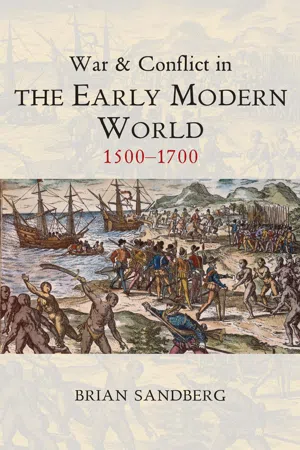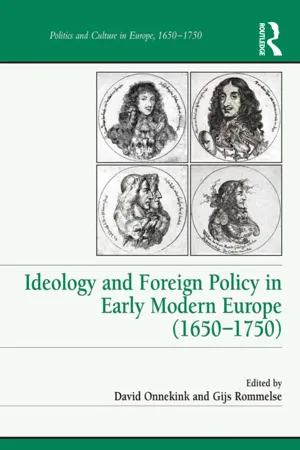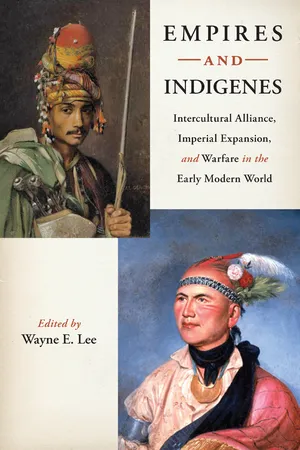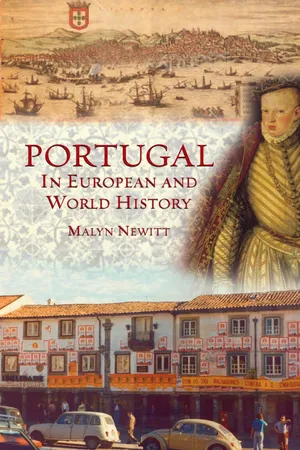History
Spanish Maritime Empire
The Spanish Maritime Empire refers to the vast overseas territories and trade routes controlled by Spain during the Age of Exploration, particularly in the 16th and 17th centuries. It encompassed territories in the Americas, Asia, and the Pacific, and was characterized by extensive maritime exploration, colonization, and trade. The empire played a significant role in shaping global trade and politics during this period.
Written by Perlego with AI-assistance
Related key terms
5 Key excerpts on "Spanish Maritime Empire"
- eBook - ePub
War and Conflict in the Early Modern World
1500 - 1700
- Brian Sandberg(Author)
- 2016(Publication Date)
- Polity(Publisher)
Books of city views portrayed urban centers in New Spain, such as Mexico and Cuzco, as well as new colonial settlements. Mapping colonial cities and roads provided coordinates for understanding imperial space, as well as establishing population control and commercial power in the Americas and the Indian Ocean. As cartographers worked to map the growing maritime empires of the Portuguese, Spanish, and Ottomans, they also had to grapple with how to consider other competing maritime powers. 25 Several regional maritime empires in Eurasia and Africa seem to have had the potential to become global maritime empires around 1500. Gujarati merchants had extensive Indian Ocean networks, but their city-state ports lacked centralized political authority. Mameluk Egypt, as discussed above, controlled much of the spice trade in the Indian Ocean in the early sixteenth century, but fell to Ottoman conquest in 1517. The sultanate of Aceh on the northern tip of the island of Sumatra developed a formidable fleet in the sixteenth century, allowing it to compete with the Portuguese for control of trade in the eastern Indian Ocean. The Acehans constructed walled fortifications to defend their cities from the Portuguese threat in Indonesia. Japanese mariners maintained significant maritime trading networks between Honshu, Shikoku, Kyushu, and smaller islands. Chinese merchants continued to trade in the South China Sea, but the Chinese emperors had decisively abandoned their bid at constructing a maritime empire. Regional maritime powers in the Baltic and North Seas also seem to have had the potential to develop global empires. The Hanseatic League had dominated commerce in the Baltic since the late medieval period and might have transitioned into a maritime empire, but the growing kingdom of Denmark controlled the Sound, the crucial passages between the Baltic and the North Sea. Danish kings constructed a navy around 1500, arming ships with artillery - Gijs Rommelse, David Onnekink(Authors)
- 2016(Publication Date)
- Routledge(Publisher)
The development of an exclusivist commercial policy with the American colonies led to the consolidation of an imperialist and unifying ideology based on the defence of the Catholic faith. As far as the Spanish crown was concerned, the American colonies were its property and only Catholic citizens were entitled to trade with and travel to them. This idea of commercial monopoly with America, a concept institutionally and officially endorsed and structured, never actually worked. The social and economic circumstances in Spain created a situation very different from that which the laws of the crown sought to accomplish. What, then, was the true nature of this Spanish empire and the ideological system that supported it, with regards to the maintenance of the trading and exploitation monopoly in the colonies?In terms of territory, the Hispanic Monarchy, at the beginning of the eighteenth century, was a superpower becoming hegemonic in Europe once the various territories came under its jurisdiction. In the new diplomatic context of the second half of the seventeenth century, the ownership of certain territories in Europe or the huge American expanse with the wealthy trade it generated was a diplomatic and military wake up-call to France and the Maritime Powers to contest this hegemony. For Spanish ideologists, the development of this empire was based on the construction of a state monopoly for the economic exploitation of the colonies, albeit sustained by a broad philosophical, political and ideological corpus of ideas which appears in the literature and in the political and economic writings of the so-called arbitristas like Pedro Rivadeneira (Tratado de la religion y virtudes que debe tener el principe cristiano para gobernar y conservar sus Estados ), Father Marquez (Gobernador cristiano ), Sancho de Moncada (Restauración politica de España ) or Diego de Saavedra Fajardo (Idea de un principe cristiano ).14- eBook - ePub
Empires and Indigenes
Intercultural Alliance, Imperial Expansion, and Warfare in the Early Modern World
- Wayne E. Lee(Author)
- 2011(Publication Date)
- NYU Press(Publisher)
25However un-paradigmatic they were in reality, contemporaries and historians often pointed to the spectacular early Spanish successes in Mexico and Peru and the appearance of gaining a vast territorial empire in a way that portrayed this experience as substantially different from those of the other “empires” discussed in this book. In the sense that those early successes produced unprecedented access to mineral wealth, the Spanish experience was indeed exceptional. Nevertheless, Spanish administrators and adventurers confronted the problems of controlling territory, of blending different cultures of war, and of depending on indigenous allies (with the parallel need to accommodate those allies politically). Each of those problems had parallels in the other empires of the era.Intercultural Alliance, Imperial Expansion, and Warfare
Like Spain, all the empires discussed in this book depended on intercultural alliances to make their expansion work, and in so doing, they evolved new forms of warfare. Within these titular themes are a number of common concepts and terms. One of the most important has already been used in this introduction rather indiscriminately and perhaps needs some clarification. That term is indigenous . The Ottomans and Muscovites discussed here by Aksan and Jones, for example, almost never dealt with indigenous people, as that term is usually defined. But worries over whether any one people were truly autochthonous is less the issue here than the nature of the relationships generated by an expanding state-based society moving into the territory of a people with generations of experience with the local climate, terrain, and subsistence system. Even this definition is inadequate, however, as it might describe almost any conquest situation (for example, the Normans over the Saxons). So to that basic understanding of “local,” we must add that the two societies operated according to different cultural systems, often set by the different scale of their social organization and especially by their use of different forms and even meanings of warfare.26 - eBook - ePub
- Malyn Newitt(Author)
- 2009(Publication Date)
- Reaktion Books(Publisher)
4 The First European Maritime Empire The Estado da Índia During the sixteenth century the Portuguese created a worldwide commercial empire stretching from the China Sea and the Indian Ocean to Brazil and Angola in the South Atlantic. This empire, which was not challenged by any other European state for a hundred years, made a profound long-term impact on the economy and culture of Europe and initiated changes in the relations of Europe with the rest of the world, which can today be recognized as the beginnings of globalization. 1 After Vasco da Gama returned to Lisbon in 1499 from his successful first voyage to India, the king, Dom Manuel I, realized that great profits could be earned from direct voyages to India. War between Venice and the Turks had put a premium on the value of spices imported into Europe and the sea route round the Cape was not only far beyond the reach of Turkish power but enabled greatly increased quantities of spices to be imported. A second fleet was quickly organized, this time consisting of fourteen ships. To equip such a fleet was beyond the resources of the Crown, so Italian and German banks were allowed to invest in the voyage. Its commander, Pedro Álvares Cabral, lost four of his ships in storms (including one captained by Bartolomeu Dias), and engaged in open warfare with the ruler of Calicut (now Kozhikode), the principal pepper trading port of the Malabar coast. Although the voyage produced spectacular profits it showed something of the problems that would be faced by fleets sent annually from Portugal. The ships had no secure base in which to re-equip and carry out repairs and, because of the violence employed by the Portuguese on their early voyages, they now had to contend with a hostile reception in many of the trading ports in the Indian Ocean. Having to fight wars in the East had not been foreseen and raised major issues of supply and manpower - eBook - ePub
The Golden Age of Piracy
The Rise, Fall, and Enduring Popularity of Pirates
- David Head(Author)
- 2018(Publication Date)
- University of Georgia Press(Publisher)
13 France was last to win these concessions, doing so in the Treaty of Ryswick of 1697. By that time it held not only islands in the eastern Caribbean but Tortuga and a portion of the Spanish island of Santo Domingo. The treaty divided that island, giving France one end as the new colony of Saint-Domingue (today’s Haiti). Centuries of pressure from rival European powers finally caused Spain to abandon its exclusive claims to the entire region. Although its implications only gradually became clear, this change also set the stage for a unified opposition to piracy across all these powers. Non-Spanish governments came to oppose piratical activities once raiders no longer targeted an intransigent Spanish enemy who blocked their presence but instead hampered their own ability to profit from peaceful trade. Spanish acceptance of rivals within its American space thus established the conditions for a coordinated campaign against unauthorized seaborne violence.Sites of Interloping
For two centuries starting in 1500, Spain made grand claims and enacted strict policies but proved unable to enforce them. Counting just the areas they actively held and ruled, the extent of their American empire was truly remarkable. At the same time, it encompassed only a portion of the areas of North America, the Caribbean, and South America outside Portuguese Brazil. In addition to failing to hold all that it claimed, the Spanish Empire in the Americas embraced underpopulated, peripheral locations that saw very little trade or other interaction with the central Spanish settlements and economies. These peripheral regions inclined to open their ports to foreigners, especially if the occasional contraband trader brought much-needed items. Before the Spanish authorities caught up with John Hawkins to destroy most of his ships in the Battle of San Juan de Ulúa off Vera Cruz, he had successfully sold three cargoes of enslaved Africans to willing Spanish purchasers.14
Index pages curate the most relevant extracts from our library of academic textbooks. They’ve been created using an in-house natural language model (NLM), each adding context and meaning to key research topics.




